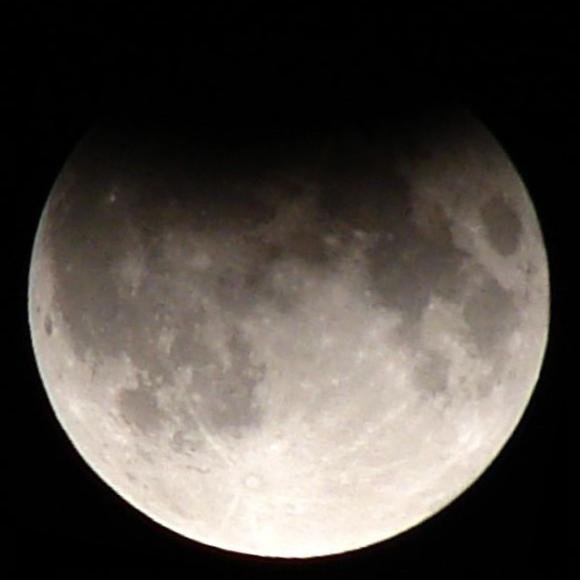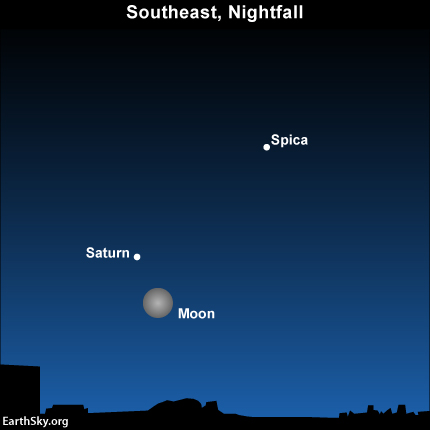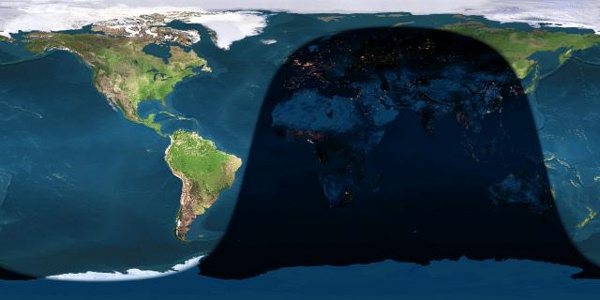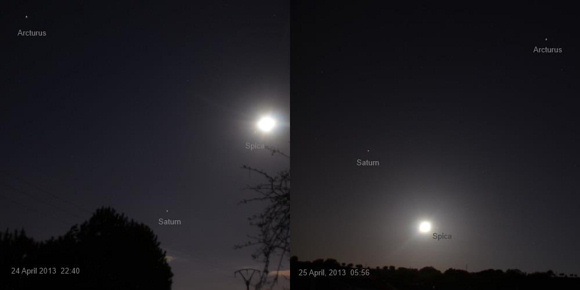


On the night of April 25, 2013 – the night of the partial lunar eclipse – the bright object near the moon is the planet Saturn.

On April 25-26, the full moon stays primarily within Earth’s faint penumbral shadow. Only the northernmost part of the moon dips into the dark umbral shadow, creating a brief partial eclipse. Image via Wikimedia Commons
What causes a partial eclipse? A lunar eclipse can only happen at full moon, when the moon lies generally opposite the sun in Earth’s sky. When Earth resides directly in between the moon and sun, then the Earth’s dark shadow totally falls upon the moon’s surface. On April 25-26, the alignment of sun-Earth-moon is a little off, so it’s only a partial eclipse.
A lunar eclipse happens when the long shadow of Earth touches the moons face. Earth’s shadow has two parts: a dark innerumbra and lighter surrounding penumbra. The moon does go into the darkest part of Earth’s shadow tonight, the umbral shadow, but only briefly. Thus tonight’s eclipse is an extremely shallow partial lunar eclipse, with only the northernmost portion of the moon passing through the Earth’s dark shadow for about 27 minutes. At the greatest eclipse, the Earth’s dark shadow will cover less than 1.5% of the moon’s diameter.
If you were on the part of the moon covered over by the Earth’s dark shadow, you’d see a total eclipse of the sun. Elsewhere on the side of the moon that faces Earth, you’d see a partial solar eclipse.
Worldwide map of 2013 April 25 partial eclipse of the moon
Who will see tonight’s eclipse? The worldwide map above shows where the lunar eclipse is visible from Earth. Where the gray swaths (South America, New Zealand) bracket the inner white area, there is only a hard-to-see faint penumbral eclipse. To view tonight’s partial umbral eclipse, you really have to live within the whiter portions on this map.
From the most of Europe and western Africa, the moon will be partially eclipsed shortly after sunset on April 25. Look low in your eastern sky. Binoculars may help you view the eclipse in the haze of dusk.
From the Middle East and western Asia, the partial eclipse happens at late night or around midnight April 25/26. The moon will be high in the sky in this part of the world.
From Australia, Indonesia or eastern Asia, the lunar eclipse takes place before sunrise on April 26. Look low in your western sky. Again, binoculars may help you to better see the eclipse in the haze of morning twilight.

Partial lunar eclipse of June 4, 2012 as captured by EarthSky Facebook friend Laurel Nendza. Thank you, Laurel!
What time should I watch for the eclipse? An eclipse happens at the same moment for the entire Earth, and thus our clocks say different times. We give the eclipse times below in Universal Time. Click here to find out how to convert Universal Time to the clock time in your time zone.
Penumbral Eclipse Begins: 18:03:38 UT
Partial Eclipse Begins: 19:54:08 UT
Greatest Eclipse: 20:07:30 UT
Partial Eclipse Ends: 20:21:02 UT
Penumbral Eclipse Ends: 22:11:26 UT
Partial Eclipse Begins: 19:54:08 UT
Greatest Eclipse: 20:07:30 UT
Partial Eclipse Ends: 20:21:02 UT
Penumbral Eclipse Ends: 22:11:26 UT
Day and night sides of Earth at greatest eclipse

Day and night sides of Earth at greatest eclipse (2013 April 25 at 20:07:30 Universal Time). Image credit: Earth and Moon Viewer
Day and night on Earth at maximum eclipse. The map above shows you the day and night sides of Earth at the moment of greatest partial lunar eclipse (20:07:30 Universal Time on April 25). The shadow line to the right (running through Asia and to the left of New Zealand) represents sunrise. The shadow line to the left (running in between South America and Africa) represents sunset.
If the greatest eclipse happens at or near sunset (or sunrise) in your part of the world, look low in the opposite direction just after sunset (or before sunrise) for the eclipsed moon by the horizon. An unobstructed horizon and binoculars will undoubtedly enhance the view of the eclipse in the twilight glare.
Two more lunar eclipses are on tap for 2013 – on May 25 and October 18/19 – but both of them will be penumbral eclipses. During a penumbral lunar eclipse, the moon misses the Earth’s dark umbral shadow completely but passes through the faint penumbral shadow surrounding the dark umbra.
Bottom line: Parts of the world on April 25-26, 2013 (but not North or South America) will be able to watch a shallow partial eclipse of the full moon. This post contains eclipse info, including times, who will see it, and eclipse maps.
,


No comments:
Post a Comment